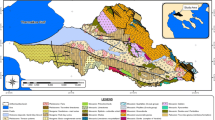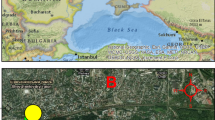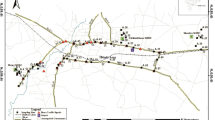Abstract
Copper ore mining and processing are among the most harmful anthropogenic influences for the environment and they are a subject of international and national law regulations. Recultivation of areas influenced by mining and processing industry is commonly applied and monitored in order to restore as much as possible the natural environment. In this study, environmental magnetic methods are applied in order to assess the degree of soil restoration in terms of soil development, after remediation of waste dump from Cu-processing plant. Soils developed under birch forest stands of different age (5, 15, and 25 years) as well as raw waste material were sampled along depth down to 20–30 cm. Variations in magnetic parameters and ratios obtained (magnetic susceptibility, frequency-dependent magnetic susceptibility, anhysteretic remanence (ARM), isothermal remanence (IRM), ARM/IRM100mT) suggest the presence of magnetic enhancement in the upper 0–15 cm, the thickness of this layer varying depending on the age of the forest stand. Magnetic mineral responsible for this enhancement is of magnetite type, while waste material contains a large amount of hematite, as evidenced by coercivity analysis of IRM acquisition curves and thermal demagnetization of composite IRM. Magnetic grain-sized proxy parameters suggest that magnetite particles are coarser, magnetically stable, while no or minor amount of superparamagnetic grains were detected at room temperature. A well-defined linear regression between the topsoil magnetic susceptibility and the approximate age of the forest stand provides an indication that the magnetic enhancement is of pedogenic origin. It is concluded that the observed magnetic enhancement of recultivated soils studied is linked to a combined effect of pedogenic contribution and possible additions of industrial ashes as a liming agent for soil restoration.








Similar content being viewed by others
References
Adriano, D. C., Wenzel, W. W., Vangronsveld, J., & Bolan, N. S. (2004). Role of assisted natural remediation in environmental cleanup. Geoderma, 122(2–4), 121–142.
Banov, M. & Pavlov, P., (2015). Physico-chemical characterization of dumps, built during excavation of copper mining. Annual of the University of Mining and Geology “St. Ivan Rilski”, Vol. 58, Part ІI, Mining and Mineral processing, 38–40.
Bolan, N. S., Park, J. H., Robinson, B., Naidu, R., & Hug, K. Y. (2011). Phytostabilization: a green approach to contaminant containment. Advances in Agronomy, 112, 145–204.
Boyko, T., Scholger, R., Stanjek, H., & MAGPROX-Team. (2004). Topsoil magnetic susceptibility mapping as a tool for pollution monitoring: repeatability of in-situ measurements. Journal of Applied Geophysics, 55(3–4), 249–259.
Bradshaw, A. (1997). Restoration of mined lands—using natural processes. Ecological Engineering, 8, 255–269.
Cornell, R., & Schwertmann, U. (2003). The iron oxides. Structure, properties, reactions, occurrence and uses. New York: Weinheim.
Courtney, R. (2013). Mine tailings composition in a historic site: implications for ecological restoration. Environmental Geochemistry and Health, 35, 79–88.
Coussy, S., Grangeon, S., Bataillard, P., Khodja, H., Maubec, N., Faure, P., Schwartz, C., & Dagois, R. (2017). Evolution of iron minerals in a 100 years-old Technosol. Consequences on Zn mobility. Geoderma, 290, 19–32.
Dearing, J. A., Hay, K. L., Baban, S. M. J., Huddleston, A. S., Wellington, E. M. H., & Loveland, P. J. (1996). Magnetic susceptibility of soil: an evaluation of conflicting theories using a national data set. Geophysical Journal International, 127, 728–734.
Dinev, N., 2016. Investigation of soil contamination in the Srednogorie region. Remediation practices and risk evaluation. In M. Teoharov & B. Christov (eds) Geochemical and agro-ecological problems in Zlatitza–Pirdop plane and the surroundings. ISBN 987–619–90414-1-3, Bulgarain Pedological Society, (in Bulgarian) 81–120.
Dudka, S., & Adriano, D. (1997). Environmental impacts of metal ore mining and processing: a review. Journal of Environmental Quality, 26, 590–602.
Dunlop, D., & Özdemir, O. (1997). Rock magnetism. Fundamentals and frontiers. In D. Edwards (Ed.), Cambridge studies in magnetism. Cambridge: University Press.
Evans, M., & Heller, F. (2003). Environmental magnetism: principles and applications of enviromagnetics. San Diego, CA: Academic Press.
Frank, U., Nowaczyk, N. R. (2008) Mineral magnetic properties of artificial samples systematically mixed from haematite and magnetite. Geophysical Journal International, 175 (2):449–461.
Grimley, D., & Arruda, N. (2007). Observations of magnetite dissolution in poorly drained soils. Soil Science, 172(12), 968–982.
Hanesch, M., & Scholger, R. (2002). Mapping of heavy metal loadings in soils by means of magnetic susceptibility measurements. Environmental Geology, 42(8), 857–870.
Heller, F., Strzyszcz, Z., & Magiera, T. (1998). Magnetic record of industrial pollution in forest soils of upper Silesia. Poland. J. Geophys. Res., 103(B8), 17767–17774.
IUSS Working Group WRB (2014). World Reference Base for Soil Resources 2014. International soil classification system for naming soils and creating legends for soil maps. World Soil Resources Reports No. 106. FAO, Rome.
Jordanova, N., 2016. Soil magnetism. Applications in pedology, environmental science and agriculture. 1st Edition, Academic Press (Elsevier), 2016, ISBN:9780128092392, 466 pp.
Jordanova, D., Jordanova, N., & Hoffmann, V. (2006). Magnetic mineralogy and grain-size dependence of hysteresis parameters of single spherules from industrial waste products. Physics of the Earth and Planetary Interiors, 154, 255–265.
Jordanova, N., Jordanova, D., & Ts, T. (2008). Application of magnetometry for delineation of anthropogenic pollution in areas covered by various soil types. Geoderma, 144(3–4), 557–571.
Jordanova, D., Goddu, S. R., Kotsev, T., & Jordanova, N. (2013). Industrial contamination of alluvial soils near Fe-Pb mining site revealed by magnetic and geochemical studies. Geoderma, 192, 237–248.
Kabata-Pendias, A. and Pendias, H., 2001. Trace elements in soils and plants. 3rd Edition. CRC Press, Boca Raton London New York Washington, D.C., 403 pp., ISBN 0–8493–1575-1
Kruiver, P., Dekkers, M., & Heslop, D. (2001). Quantification of magnetic coercivity components by the analysis of acquisition curves of isothermal remanent magnetization. Earth and Planetary Science Letters, 189, 269–276.
Liu, Q., Roberts, A., Larrasoaña, J., Banerjee, S., Guyodo, Y., Tauxe, L., & Oldfield, F. (2012). Environmental magnetism: principles and applications. Reviews of Geophysics, 50, RG4002.
Lombi, E., Wenzel, W., & Adriano, D. (1998). Soil contamination, risk reduction and remediation. Land Contamination & Reclamation, 6(4), 183–197.
Long, X., Ji, J., Barrón, V., & Torrent, J. (2016). Climatic thresholds for pedogenic iron oxides under aerobic conditions: processes and their significance in paleoclimate reconstruction. Quaternary Science Reviews, 150, 264–277.
Lowrie, W. (1990). Identification of ferromagnetic minerals in a rock by coercivity and unblocking temperature properties. Geophysical Research Letters, 17(2), 159–162.
Lu, S., Yu, X., & Chen, Y. (2016). Magnetic properties, microstructure and mineralogical phases of technogenic magnetic particles (TMPs) in urban soils: their source identification and environmental implications. The Science of the Total Environment, 543(Part A), 239–247.
Magiera, T., Strzyszcz, Z., Kapicka, A., Petrovsky, E. (2006) Discrimination of lithogenic and anthropogenic influences on topsoil magnetic susceptibility in Central Europe. Geoderma, 130(3–4):299–311.
Magiera, T., Jabłońska, M., Strzyszcz, Z., & Rachwal, M. (2011). Morphological and mineralogical forms of technogenic magnetic particles in industrial dusts. Atmospheric Environment, 45(25), 4281–4290.
Magiera, T., Gołuchowska, B., & Jabłońska, M. (2013). Technogenic magnetic particles in alkaline dusts from power and cement plants. Water, Air, & Soil Pollution, 224, 1389.
Maher, B. (1986). Characterization of soils by mineral magnetic measurements. Physics of the Earth and Planetary Interiors, 42, 76–92.
Maher, B. A. (1998). Magnetic properties of modern soils and quaternary loessic paleosols: paleoclimatic implications. Palaeogeography Palaeoclimatology Palaeoecology, 137, 25–54.
Maxbauer, D., Feinberg, J., & Fox, D. (2016). Magnetic mineral assemblages in soils and paleosols as the basis for paleoprecipitation proxies: a review of magnetic methods and challenges. Earth-Science Reviews, 155, 28–48.
Meuser, H. (2013). Soil remediation and rehabilitation. Treatment of contaminated and disturbed land. Springer, Environmental Pollution, Vol. 23. In B. J. Alloway & J. T. Trevors (eds.) pp. 406, ISBN 978–94–007-5750-9.
Mullins, C. E. (1977). Magnetic susceptibility of the soil and its significance in soil science—a review. Journal of Soil Science, 28(223), 246.
Mullins, C. E., & Tite, M. S. (1973). Magnetic viscosity, quadrature susceptibility, and frequency dependence of susceptibility in single-domain assemblies of magnetite and maghemite. Journal of Geophysical Research, 78, 804–809.
Oldfield, F., 1999. The rock magnetic identification of magnetic mineral and magnetic grain size assemblages. 98–112, In J. Walden, F. Oldfield & J. Smith (eds.) Environmental magnetism. A practical guide. Technical guide No6, Quaternary Research Association, London.
Petrova, R. (2009). Decisions for rehabilitation and phytoremediation of degraded soils—copper tailing pond ‘Medet’. FORESTRY IDEAS 2/2009 (38), 68–76.
Petrovský, E. & Elwood, B. (1999). Magnetic monitoring of air-, land- and water pollution. In: B. Maher & R. Thompson (eds.) Quaternary climates, environments and magnetism. Eds. , Cambridge Univ. Press., pp. 279–322.
Pulford, I., & Watson, C. (2003). Phytoremediation of heavy metal-contaminated land by trees—a review. Environment International, 29, 529–540.
Roberts, A. (2015). Magnetic mineral diagenesis. Earth-Science Reviews, 151, 1–47.
Rumpel, C., Kögel-Knabner, I., Knicker, H., Hüttl, R.F. (2000) Composition and distribution of organic matter in physical fractions of a rehabilitated mine soil rich in lignite-derived carbon. Geoderma, 98(3–4):177–192.
Rumpel, C., Knicker, H., Kögel-Knabner, I., Skjemstad, J.O., Hüttl, R.F. (1998). Types and chemical composition of organic matter in reforested lignite-rich mine soils. Geoderma, 86, 123–142
Salt, D., Smith, R., & Raskin, I. (1998). Phytoremediation. Annual Rev. Plant Physiol., 49, 643–668.
Schaetzl, R., & Anderson, A. (2009). Soils. Genesis and geomorphology. Cambridge: Cambridge Univ. Press ISBN 978-0-521-81201-6.
Skjemstad, J.O. & Baldock, J.A. (2007). Total and organic carbon. In M. R. Carter & E. G. Gregorich (Eds.) Soil sampling and methods of analysis. CRC Press, pp. 225–237
Séré, G., Schwartz, C., Ouvrard, S., Renat, J-C., Watteau, F., Villemin, G., Morel, J. L. (2010) Early pedogenic evolution of constructed Technosols. Journal of Soils and Sediments, 10(7):1246–1254.
Šourková, M., Frouz, J., Šantrùčková, H. (2005) Accumulation of carbon, nitrogen and phosphorus during soil formation on alder spoil heaps after brown-coal mining, near Sokolov (Czech Republic). Geoderma, 124(1–2):203–214.
Tsolova, V., Hristova, M., Borras, J., Pascual, N., & Banov, M. (2014). Pb, Cu and Zn geochemistry in reclaimed soils (technosols) of Bulgaria. Journal of Geochemical Exploration, 144, 337–344.
Uzarowicz, Ł., & Skiba, S. (2011). Technogenic soils developed on mine spoils containing iron sulphides: mineral transformations as an indicator of pedogenesis. Geoderma, 163, 95–108.
Vangronsveld, J., Van Assche, F., Clijsters, H. (1995) Reclamation of a bare industrial area contaminated by non-ferrous metals: In situ metal immobilization and revegetation. Environmental Pollution, 87(1):51–59.
Wang, B., Xia, D., Yu, Y., Jia, J., Nie, Y., & Wang, X. (2015). Detecting the sensitivity of magnetic response on different pollution sources—a case study from typical mining cities in northwestern China. Environmental Pollution, 207, 288–298.
Yang, T., Liu, Q., Chan, L., & Cao, G. (2007). Magnetic investigation of heavy metals contamination in urban topsoils around the East Lake, Wuhan, China. Geophysical Journal International, 171(2), 603–612.
Acknowledgements
This study is carried out in the frames of a bilateral cooperation project between the NIGGG at Bulgarian Academy of Sciences and Institute of Geophysics at the Acad. Sci. Czech Rep. E. Petrovsky is grateful for the support provided by the Ministry of Education, Youth and Sports of the Czech Republic through INGO Project LG15036. We highly appreciate constructive comments and suggestions given by the Editor Dr. Jose Alexander Elvir and the two anonymous reviewers which helped to improve the manuscript.
Author information
Authors and Affiliations
Corresponding author
Rights and permissions
About this article
Cite this article
Jordanova, N., Petrovský, E., Kapicka, A. et al. Application of magnetic methods for assessment of soil restoration in the vicinity of metallurgical copper-processing plant in Bulgaria. Environ Monit Assess 189, 158 (2017). https://doi.org/10.1007/s10661-017-5834-5
Received:
Accepted:
Published:
DOI: https://doi.org/10.1007/s10661-017-5834-5




